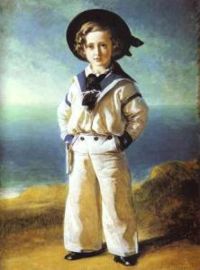- Sailor suit
-
 Prince Albert Edward (The future Edward VII of the United Kingdom) in a sailor suit, by Franz Xaver Winterhalter, 1846
Prince Albert Edward (The future Edward VII of the United Kingdom) in a sailor suit, by Franz Xaver Winterhalter, 1846
A sailor suit is a uniform traditionally worn by enlisted seamen in the navy, and other government funded sea services. It later developed in to a popular clothing style for children.
Only in the early nineteenth century, after the Napoleonic wars, did governments start prescribing a standard uniform.
In the Royal Navy, the sailor suit or naval rig [1] is known as Number One uniform and is worn by Able Rates and Leading Hands. It is primarily ceremonial, although it dates from the old working rigs of Royal Navy sailors which has changed continuously since its first introduction in 1857 [2].
The blue jean collar is perhaps the most recognisable item of the sailor suit, and tradition says that it dates from the times when seamen wore tarred pigtails.[3] This is in fact false, as the collar was not part of uniform until after pigtails disappeared [2]. The three stripes have nothing to do with Nelson's three victories but was simply standardised to 3 when uniform was regulated.[4] It is often considered lucky to touch a sailor's collar.[5]
The bell bottomed trousers were designed so that they could be rolled up easily when scrubbing the decks. Ratings used to have either 5 or 7 horizontal creases and this did not represent the seven seas or five oceans but depended on the length of the sailor's leg.
The lanyard was originally used to fire the cannons on board ship. Later, a sailor would carry his knife with it.
In the United States, the first standard uniform was issued in 1817. Through government procurement, winter and summer uniforms were provided. White duck jacket, trousers and vest made up the summer uniform, while the winter uniform consisted of a blue jacket and trousers, red vest with yellow buttons and a black hat.[6]
In 1846, the four-year-old Albert Edward, Prince of Wales was given a scaled-down version of the uniform worn by ratings on the Royal Yacht. He wore his miniature sailor suit during a cruise off the Channel Islands that September, delighting his mother and the public alike. Popular engravings, including the famous portrait done by Winterhalter, spread the idea, and by the 1870s, the sailor suit had become normal dress for both boys and girls all over the world.
In several East Asian countries, some schools continue to prescribe sailor-themed wear as school uniforms (Sailor fuku) for girls. In Japan, it has become prominent within manga and anime - the most iconic example of this being the Sailor Moon series. Some Western cartoon and comic characters also use a sailor suit as their trademarks; examples include Popeye, Donald Duck and Spoilt Bastard.
Through the years, sailor suit has characterized the performances of the Vienna Boy's Choir all over the world.
When doing the Sailor's Hornpipe dance, a Highland character dancer is required to wear a sailor suit.
Notes
- ^ http://www.britishempire.co.uk/glossary/r.htm
- ^ http://www.naval-history.net/WW2aaNavalLife-Customs1.htm#2
- ^ http://www.royalnavy.mod.uk/training-and-people/rn-life/uniforms-and-badges-of-rank/the-history-of-rating-uniforms/
- ^ Encyclopedia of Superstitions 1949, Edwin Radford, Mona A. Radford, Kessinger Publishing (p. 208)
External links
Categories:- Uniforms
- Children's clothing
- Suits (clothing)
- Sailors
Wikimedia Foundation. 2010.
